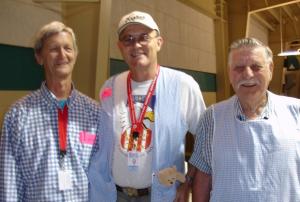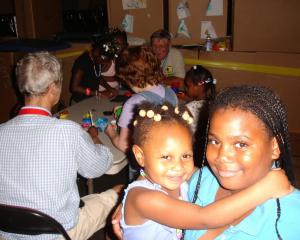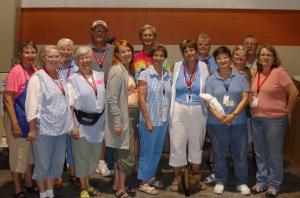I came home at noon on Friday, August 29, to find a message that I should call about a possible assignment as a volunteer for Children’s Disaster Services to provide child care for victims of Hurricane Gustav in Louisiana. I said yes. Two days later I flew to Alexandria, Louisiana, and began my adventures.
The Shelter: Children’s Disaster Services (CDS) is a non-sectarian ministry of the Church of the Brethren that works closely with the American Red Cross and FEMA to provide therapeutic child care in their Disaster Service Centers and, more recently, in their shelters. This was CDS’ second shelter child care experience, but it was like none other. Eight of us were to provide care for the children among thousands of victims staying in a newly-constructed, $26 million mega-shelter longer and wider than 3 football fields, situated among the cotton fields on the agricultural campus of LSU south of Alexandria, LA. At Save the Children’s request, CNN did a nice piece about it: http://nyredcross.wordpress.com/2008/09/04/cnn-video-terry-on-shelter-for-kids/ , then click on the CNN video.
Not only did we need to care for these children; we and they had to put up with the growing pains of a newly opened building whose design was not particularly attuned to its intended use. The building had no kitchen, not even a microwave oven or a pot and hotplate to boil water for tea. It had one or two computers, but no Internet connection. It had no copiers or faxes. What it did have was a steel structure built to withstand 170 mph winds, lots of lightning rods, lots of bathrooms including showers, plenty of concrete floor space, and a small parking lot outside. Despite a disorganized arrival in Alexandria, I ended my day on a Red Cross cot in a staff dormitory of about 50 men, all seeming to sleep better on those instruments of torture than I did, as my new knee got along very poorly with the cot’s support bars.
Monday, September 1, the day of the hurricane, dawned, and I was introduced to our child care center and the 7 other volunteers who also staffed it. The center was in the corner of a huge room that was filling rapidly with ambulance crews from all over the country who were being staged at our shelter until called out to rescue folks from Gustav. The center had “walls” of big cardboard cartons that had held Red Cross cots, a hard concrete floor, and a few tables and chairs for our activities. Save the Children had provided most of the toys and supplies for the center, where up to 25 children could play with chalk, tempera paints, beads and other crafts, Duplo blocks, construction toys, cars and trucks, plastic animals, play dough, books, puppets, and dolls. We also had balls, Frisbees, and jump ropes for older children, but these activities turned out to be a bit too boundless and chaotic for us to manage successfully inside. We had daily sessions from 9-12, 2-5, and 7-8 or 8:30, although we dropped the evening sessions after a couple of nights because of low attendance and tired volunteers. In all we helped about 360 children, most of them between 3 and 8, although some of the “three year olds” were really small and in diapers, and some of the “8 year olds” looked like young adults. Early on we found that toddlers would usually get separation anxiety because of getting care from strangers away from home, and teenagers tended to need more movement than we offered.
 Enter Gustav: Hurricane Gustav, my first and I hope my last hurricane, showed up in force Monday afternoon, when the doors were shut and on our breaks we could watch the 80 mph wind and rain lash the trees. That night the Shelter held over 3,000 clients, as well as about 400 volunteers and a large number of hospital and nursing home patients from elsewhere in Louisiana. Busloads of folks from New Orleans and other coastal parishes had been joined by large numbers who came from lowlands near and far. Soon after the wind started blowing strongly we lost electric power; however, we did have a good generator, which provided lighting for the building until full power was restored on Wednesday evening. Gustav must have enjoyed our company, because he sat on top of us with wind and 9.5 inches of rain until Wednesday afternoon. Tuesday morning a tornado about 10 miles away from us killed two people, so we set up an alternative location for the children with tarps and rugs next to the steel girders on an inside corner. Fortunately we didn’t have to use it. The building got kind of stuffy, especially without air conditioning. My wife and I had a laugh about the 50 sweaty men in their skivvies trying to sleep in an unventilated room.
Enter Gustav: Hurricane Gustav, my first and I hope my last hurricane, showed up in force Monday afternoon, when the doors were shut and on our breaks we could watch the 80 mph wind and rain lash the trees. That night the Shelter held over 3,000 clients, as well as about 400 volunteers and a large number of hospital and nursing home patients from elsewhere in Louisiana. Busloads of folks from New Orleans and other coastal parishes had been joined by large numbers who came from lowlands near and far. Soon after the wind started blowing strongly we lost electric power; however, we did have a good generator, which provided lighting for the building until full power was restored on Wednesday evening. Gustav must have enjoyed our company, because he sat on top of us with wind and 9.5 inches of rain until Wednesday afternoon. Tuesday morning a tornado about 10 miles away from us killed two people, so we set up an alternative location for the children with tarps and rugs next to the steel girders on an inside corner. Fortunately we didn’t have to use it. The building got kind of stuffy, especially without air conditioning. My wife and I had a laugh about the 50 sweaty men in their skivvies trying to sleep in an unventilated room.
The concrete floors throughout the shelter began to sweat profusely, beginning when they warmed up Monday night after the air conditioning went off. All the floors were very slippery in places, and our little corner was one of the wettest. So early Wednesday morning I spent scrounging cardboard boxes with which we paved the floor of the center, making it both safer and more comfortable. Until the Southern Baptist 18-wheeler disaster kitchen arrived in the neighborhood late Thursday our meals were pretty basic. For this food the clients had to wait in long lines for up to an hour.
People with cars and the ambulance crews began to leave as soon as the wind died down on Tuesday, but a new difficulty arose: Our sewers were blocked. It turned out that during construction a disgruntled employee had poured a couple of bags of cement powder into the sewer pipe near a junction, so very little got through. Nobody in the shelter was allowed to shower for two days and nights, and one set of client bathrooms was closed for the week until repairs could be made. The efficient shelter manager moved Heaven and Earth to get the repairs made, and he had outhouses set up in relatively protected locations right outside the Shelter. Many of the urban children in our care had never experienced an outhouse and didn’t want to, so that added to the experience. They and their families were stuck in the shelter until buses came for them on Thursday, Friday, and Saturday. Of course in these conditions a number of children and adults became sick, so we all learned and applied the Red Cross method of washing hands. For instance, all children entering our center had to sing through “ABC” or “Happy Birthday” while applying hand cleanser to all parts of their hands and wrists. We made it into a nice little game.
Our Child Care: As the word got out among the clients about our child care, we began to see many of the same faces each day, despite the preference we gave for children who had not yet received our care. Each day we would circulate among the cots, recruiting children who looked like they were between 3 and 8. This was complicated by the fact that many of them ran pretty wild while their parents napped or schmoosed.
 One of the “regulars” was an 8 year old girl named Kayla, who made a bead bracelet then gave it to me, saying that she loved me. Also memorable was a sister, Jerry Lynn, and her two brothers whose father had died two weeks before the storm; and Tray Lynn, a 10 year old with mongolism who loved play dough; and there were quite a few others with whom we played repeatedly. Kayla and her friends called our center “the old folks’ place”, because most of us are what you might call “experienced”.
One of the “regulars” was an 8 year old girl named Kayla, who made a bead bracelet then gave it to me, saying that she loved me. Also memorable was a sister, Jerry Lynn, and her two brothers whose father had died two weeks before the storm; and Tray Lynn, a 10 year old with mongolism who loved play dough; and there were quite a few others with whom we played repeatedly. Kayla and her friends called our center “the old folks’ place”, because most of us are what you might call “experienced”.
For me some highlights of the care included James, a toddler who calmed down from acute and vocal separation anxiety while I held him and sang to him; 6 year-old Deon, who stopped acting out, wrecking other children’s work, and throwing blocks after I started talking with him sympathetically about his anger and his grief; and Trevor, who was able to paint a scene of mostly mud, rain, and advancing flood, to show his worries and how he dealt with them. The children and I particularly enjoyed making silly shapes with the increasingly sticky, dark grey mixed play dough, or singing songs we made up. Toward the end of the week the Red Cross Shelter Manager told Tom, our group leader, in a meeting, that we had made the difference between survival and success for the shelter, because the children would come back to the cots with smiles on their faces that gave the parents a hope of return to normalcy.
(Almost Ike): Relief came to our group when two additional child care volunteers from Virginia showed up on Thursday, complete with a rental car that we could use to actually leave the building and do some restocking, shopping or R&R. Tom arranged for a couple of motel rooms for members of the team who had gotten sore throats or sore muscles, and by the week’s end we were able to move most, then all, of us to motels.
On Friday the Shelter Manager decided to close the shelter Saturday for extensive repairs to the sewer system, and reopen it Wednesday for the first victims of Ike, which was then aimed at New Orleans. By then most of the clients had moved out, and only a few were left by Saturday. We were given a new and much larger, more convenient space for our center, and 3 new volunteers arrived from our CDS child care operation in Shreveport. One additional volunteer rounded out the team for Ike on Sunday. Monday and Tuesday we got to work on a new Center for Children and Families, with our child care for 3-8 year olds to be surrounded on one side by an area for parents and their infants or toddlers, and on the other by an area for children and adults to watch DVD movies on a TV set donated by Save the Children, or play games that they had also donated.
 Once the new center was fully set up, we learned on Wednesday morning that the whole shelter was shutting down, because Ike now was pointing toward Texas. We got instructions from CDS to return home, and as I had reservations for Friday I stayed until then. We showed our child care setup to some Louisiana Government representatives who were preparing to run the shelter next time it was needed, then we packed up the stuff that could be used in other disasters. When Ike shifted its course again on Thursday, the local Red Cross folks decided to open a smaller shelter close to town, and they planned use some of our equipment to do so.
Once the new center was fully set up, we learned on Wednesday morning that the whole shelter was shutting down, because Ike now was pointing toward Texas. We got instructions from CDS to return home, and as I had reservations for Friday I stayed until then. We showed our child care setup to some Louisiana Government representatives who were preparing to run the shelter next time it was needed, then we packed up the stuff that could be used in other disasters. When Ike shifted its course again on Thursday, the local Red Cross folks decided to open a smaller shelter close to town, and they planned use some of our equipment to do so.
On returning home I got a broadcast appeal for 10 new teams of volunteers to provide child care to victims of Ike in Texas, but I think I’ll let others answer that call. I weathered Gustav, and that seems enough for now.
For More Information:
If this kind of volunteer work appeals to you (and you’re not already doing it), please visit the CDS Website at http://www.brethren.org/genbd/BDM/CDSindex.html, or Judy Bezon at JBezon_gb@brethren.org can get information to you about the training and other features of this rewarding work.
John Surr

